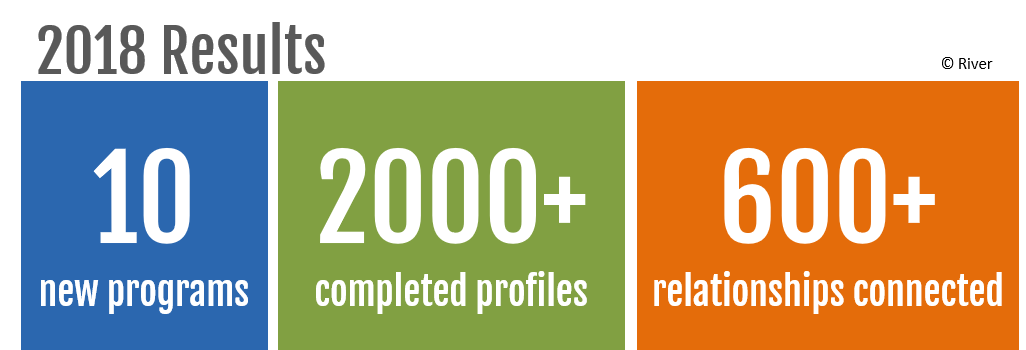River Mentoring Helps Client Achieve 700% Increase in Mentoring Relationships
A common theme we see for why companies come to River for our mentoring software and services is to create a centralized platform for all of their internal mentoring programs. I’ve worked with a number of clients over the years that had such a focus, but I have never seen one accomplish it with such rousing success as I did recently with a long-time client.
At the beginning of 2018, a new program administrator was assigned to this long-standing client’s mentoring program. The mentoring platform had always been successful, but there was always a desire from past administrators to get better usage. One universal goal was to find a way to get more of the mentoring programs that weren’t using River software within the organization to begin to use the technology. The new program administrator had the same desires and was very motivated to create a centralized location for all of the organization’s mentoring.
 As a Client Success Manager at River, my main goal is to help clients get the most they can from our mentoring platform. To that end, I met with the new program administrator from this client and we started brainstorming ways we could bring into River more of the formal mentoring programs their organization had going on outside of the platform. Some of these programs were using SharePoint sites to facilitate matching and run mentoring groups. The SharePoint sites did not provide the flexibility to expand the programs the way River could. I showed the new admin how River can create separate program pages for each group and how we can separate the audiences to allow only the select participants to collaborate with each other.
As a Client Success Manager at River, my main goal is to help clients get the most they can from our mentoring platform. To that end, I met with the new program administrator from this client and we started brainstorming ways we could bring into River more of the formal mentoring programs their organization had going on outside of the platform. Some of these programs were using SharePoint sites to facilitate matching and run mentoring groups. The SharePoint sites did not provide the flexibility to expand the programs the way River could. I showed the new admin how River can create separate program pages for each group and how we can separate the audiences to allow only the select participants to collaborate with each other.
To put these ideas into practice, we started with one of the departmental programs that was being run outside of River: Marketing. They wanted their mentees to be able to connect with mentors in a group setting, with the focus being more on who the mentor was versus a topic area. To accommodate this, I created mentoring groups that used the mentor’s name as the title for each group. The administrator and I then created a generic description for all of the groups. Once the groups had been created, I curated them into a unique program tab within River solely for the Marketing mentoring program. This allowed the mentees in this specific program to easily see all of the available mentor groups.
As with any change process, the Marketing group hit a few snags as we rolled this out. These challenges became a learning opportunity for us and helped us better prepare for future programs that launched.
 Lesson Learned #1: Limit the Number of Participants.
Lesson Learned #1: Limit the Number of Participants.
One issue we ran into was a concern that mentors would be overburdened by having too many mentees in each group. To counter this, we limited the number of mentees that could join each mentoring group. This allowed us to make the entire mentoring experience more manageable for the mentors and more personalized for the mentees.
Lesson Learned #2: Clear Group Names Make a Difference.
Another lesson we learned with the Marketing group was that we needed to provide more information about the mentor in the title and description of the engagement to make it easier for mentees to quickly decipher pertinent information. They needed to be able to easily view these details so that they could decide which group to join.
As a result of these lessons learned, we were able to more effectively set up mentoring groups for other parts of the organization without repeating any of these stumbling blocks. With the next few programs we launched, we got into a rhythm of how we set each one up and how we created the various groups that people could join. Now, each program has an image for the main page within River that shows how the mentees can easily get connected within a group. A second tab within River shows the available mentoring groups, with each group almost exclusively named for the mentor and showing their time zone, title, and department. Depending on the program (whether departmental or employee resource group based), we also have a resources section where mentees and mentors can access a variety of resources, such as videos, meeting guides, and newsletters. For this client, they have set it up so that all programs have basic mentoring resources available, while some also contain additional, program-specific resources.
While the majority of the programs that have been implemented in 2018 have focused on group mentoring, not all of the mentoring takes place within groups. We have also developed a process for people to record the informal mentoring relationships they may have started outside of River. By creating a unique template in the client’s open/public program titled “Connect with an Existing Mentor,” users are able to search for their current mentor and quickly go through the relationship creation process to record their relationship for recognition and reporting purposes. This also helps accomplish the goal of pulling more people into River for mentoring to make it their mentoring hub.
Repeatable Results
All of this hard work has paid off in big ways. As of November 2018, this client has implemented 10 new programs from across the organization, making great progress toward creating a unified mentoring experience within River. With the implementation of these new programs, more than 2000 people have completed a profile since the beginning of 2018; this is compared to only 735 new profiles created in 2017. That is an increase of 272%. There has also been a more than 700% increase in the number of relationships connected in River in 2018. This is an astounding number! The client has recorded more than 600 relationships connected in 2018 to date, as compared to 85 connected relationships for 2017.

These numbers represent an impressive growth for this client’s mentoring program, while the process we implemented creates a repeatable method to get more people mentoring. I can’t wait to see what 2019 has in store for them.








